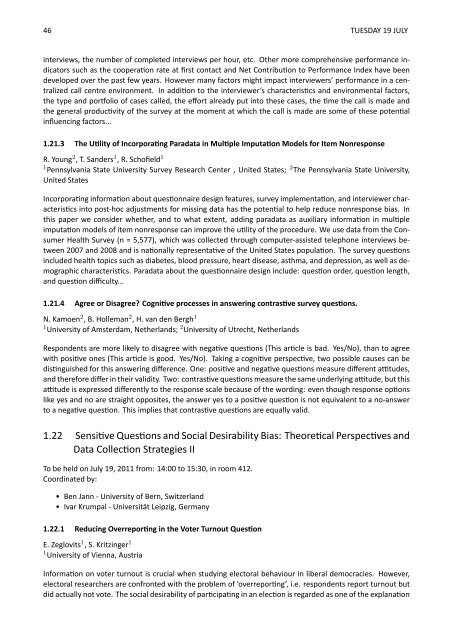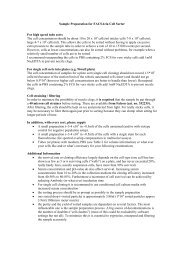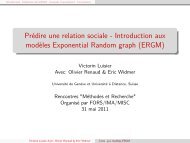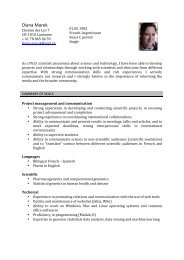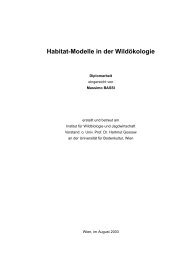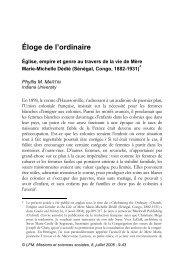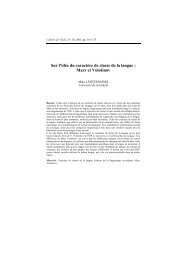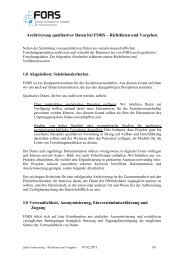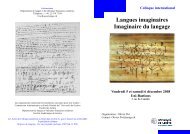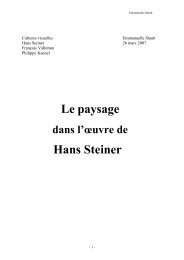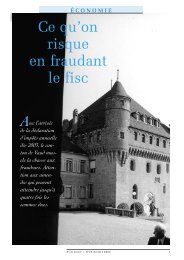conference programme book - European Survey Research ...
conference programme book - European Survey Research ...
conference programme book - European Survey Research ...
Create successful ePaper yourself
Turn your PDF publications into a flip-book with our unique Google optimized e-Paper software.
46 TUESDAY 19 JULYinterviews, the number of completed interviews per hour, etc. Other more comprehensive performance indicatorssuch as the cooperaon rate at first contact and Net Contribuon to Performance Index have beendeveloped over the past few years. However many factors might impact interviewers’ performance in a centralizedcall centre environment. In addion to the interviewer’s characteriscs and environmental factors,the type and porolio of cases called, the effort already put into these cases, the me the call is made andthe general producvity of the survey at the moment at which the call is made are some of these potenalinfluencing factors...1.21.3 The Ulity of Incorporang Paradata in Mulple Imputaon Models for Item NonresponseR. Young 2 , T. Sanders 1 , R. Schofield 11 Pennsylvania State University <strong>Survey</strong> <strong>Research</strong> Center , United States; 2 The Pennsylvania State University,United StatesIncorporang informaon about quesonnaire design features, survey implementaon, and interviewer characteriscsinto post-hoc adjustments for missing data has the potenal to help reduce nonresponse bias. Inthis paper we consider whether, and to what extent, adding paradata as auxiliary informaon in mulpleimputaon models of item nonresponse can improve the ulity of the procedure. We use data from the ConsumerHealth <strong>Survey</strong> (n = 5,577), which was collected through computer-assisted telephone interviews between2007 and 2008 and is naonally representave of the United States populaon. The survey quesonsincluded health topics such as diabetes, blood pressure, heart disease, asthma, and depression, as well as demographiccharacteriscs. Paradata about the quesonnaire design include: queson order, queson length,and queson difficulty...1.21.4 Agree or Disagree? Cognive processes in answering contrasve survey quesons.N. Kamoen 2 , B. Holleman 2 , H. van den Bergh 11 University of Amsterdam, Netherlands; 2 University of Utrecht, NetherlandsRespondents are more likely to disagree with negave quesons (This arcle is bad. Yes/No), than to agreewith posive ones (This arcle is good. Yes/No). Taking a cognive perspecve, two possible causes can bedisnguished for this answering difference. One: posive and negave quesons measure different atudes,and therefore differ in their validity. Two: contrasve quesons measure the same underlying atude, but thisatude is expressed differently to the response scale because of the wording: even though response oponslike yes and no are straight opposites, the answer yes to a posive queson is not equivalent to a no-answerto a negave queson. This implies that contrasve quesons are equally valid.1.22 Sensive Quesons and Social Desirability Bias: Theorecal Perspecves andData Collecon Strategies IITo be held on July 19, 2011 from: 14:00 to 15:30, in room 412.Coordinated by:• Ben Jann - University of Bern, Switzerland• Ivar Krumpal - Universität Leipzig, Germany1.22.1 Reducing Overreporng in the Voter Turnout QuesonE. Zeglovits 1 , S. Kritzinger 11 University of Vienna, AustriaInformaon on voter turnout is crucial when studying electoral behaviour in liberal democracies. However,electoral researchers are confronted with the problem of ’overreporng’, i.e. respondents report turnout butdid actually not vote. The social desirability of parcipang in an elecon is regarded as one of the explanaon


